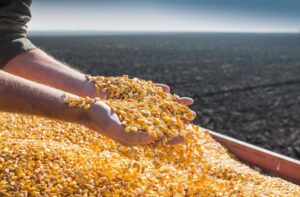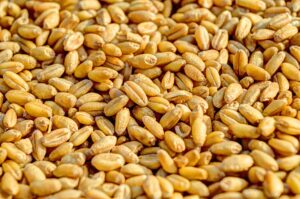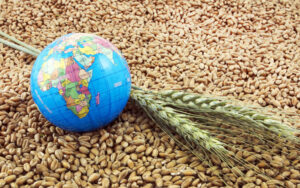
As of June 26, Ukraine exported 50.305 mln tonnes of grains and pulses since the beginning of 2023-2024 marketing year (July-June), of which 3.373 mln tonnes were shipped in June, the Ministry of Agrarian Policy and Food reported, citing the data of the State Customs Service.
According to the report, since the beginning of the current season, Ukraine has exported 18.268 million tons of wheat (831 thousand tons in June), 2.475 million tons of barley (89 thousand tons), 1.6 thousand tons of rye, and 29.02 million tons of corn (2.44 million tons).
Total exports of Ukrainian flour are estimated at 97.3 thousand tons (4.8 thousand tons in June), including 91.9 thousand tons of wheat (4.7 thousand tons in June).

As of June 22, Ukraine exported 2.2 million tons of corn, indicating a high level of activity in the market, according to the analytical cooperative “Start”, created within the framework of the All-Ukrainian Agrarian Council (AAC).
Analysts predict that June will be the most productive month for exports, but in July-August, the figures may decline significantly as the market switches to a new harvest.
“The global situation was unfavorable for Ukrainian corn. Although it is still in demand on the Italian market, its competitiveness is decreasing due to the pricing policy. For example, Argentine corn is sold at $212-213/ton on the Italian market, which is about the same level as Ukrainian corn. At the same time, Argentine corn is several dollars cheaper in Spain, making it more attractive to buyers. Under such conditions, Ukrainian traders are not in a hurry to sell their existing stocks, as their volume is limited,” the experts said.
According to their information, the corn market is entering the off-season, and prices are expected to stabilize in the coming weeks.
“If there is demand, the conditional prices for corn may fluctuate within $172-174 per ton. On average, on the CPT basis, the price will be around $170/ton in the coming weeks,” Pusk summarized.

In the 2024-2025 marketing year (MY, September 2024-August 2025), Ukraine will be able to export more than 60% of its agricultural products despite the constant shelling of critical infrastructure and problems with electricity, said Acting Minister of Agrarian Policy and Food Taras Vysotskyi during a national telethon.
“We remain an export-oriented country in terms of agriculture. Most of the products we grow will be exported. Most likely, it will be more than 60%,” he said.
Vysotsky called safe and affordable logistics the main component of agricultural exports during a full-scale war.
“The military has done a lot here. But again, we see that the enemy does not stop, constantly shelling, in particular, the southern regions. We will actively work to ensure this logistics and the necessary systematic access of critical infrastructure to energy,” he emphasized.
The Acting Minister also reminded that many export operations, such as unloading, sorting, and distribution, require electricity.
“There are relevant government decisions that guarantee that the infrastructure critical to the agricultural sector can have access to uninterrupted electricity supply. Basic facilities have been included in the list. Everything is being done to ensure that these two challenges do not stop our production and exports,” summarized the head of the Ministry of Agrarian Policy.

Ukraine, despite low prices on the global market, increased exports of most dairy products in May, both compared to April this year and compared to May 2023, Infagro, an industry information and analytical agency, reported.
According to experts, the reason for this is a significant increase in processing volumes against the backdrop of much weaker domestic sales growth than last year. Among the main commodity items, Ukraine exports the least amount of butter and cheese products. Exports of spreads, casein, and whey powder increased significantly compared to May last year.
At the same time, imports of dairy products (butter, rennet cheese, processed cheese) declined in May. Contrary to expectations, imports of cheese stopped growing. This is due to the upward trend in prices for milk and dairy products in Europe and, in particular, in Poland, the main supplier of this product to Ukraine, analysts explained.
“In June, exports of dairy products will increase further, while imports are likely to decline,” Infagro predicts.
As reported, in January-March 2024, Ukraine increased exports of dairy products by more than 40%. At the same time, imports decreased, but analysts urge domestic producers to pursue a reasonable pricing policy in order not to lose their positions in the domestic market.

As of June 21, 2023-2024 marketing year (July-June), Ukraine exported 49.54 million tons of grains and pulses, up 2.3% year-on-year, according to the website of the Ministry of Agrarian Policy and Food.
According to the report, in June, exports of grains and pulses amounted to 2.608 million tons, while a year earlier this figure was recorded at 3.087 million tons.
In terms of crops, since the beginning of the current season, Ukraine has exported 18.123 mln tonnes of wheat (686 thsd tonnes in June), 2.461 mln tonnes of barley (75 thsd tonnes), 1.6 thsd tonnes of rye (0), and 28.416 mln tonnes of corn (1.366 mln tonnes).
Total exports of Ukrainian flour as of June 21 are estimated at 96.7 thousand tons, which is 35.9% less than a year earlier. In June, Ukraine supplied 4.2 thsd tonnes to foreign markets. At the same time, in 2023-2024 MY Ukraine exported 91.3 thsd tonnes of wheat flour, and in June – 4.1 thsd tonnes.

The Ministry of Economy of Ukraine, together with the European Union and the German government, has launched a new grant program worth EUR 480 thousand, under which 12 small and medium-sized enterprises will be able to receive funding of up to EUR 40 thousand to develop their exports, the press service of the Ministry of Economy reports.
According to the report, the program is open to small and medium-sized Ukrainian businesses operating in the processing industry (food, light industry, mechanical engineering, construction, furniture manufacturing, etc.), the creative industry (fashion, design, etc.), and other industries with export and innovation potential.
The project is expected to provide 12 selected participants with a grant of up to EUR 40 thousand each, as well as group and individual consultations from experts, networking sessions, and other activities that will help identify and eliminate processes that “block” businesses on the way to export and innovation development.
Applications for participation in the grant program can be submitted until 23:59 on June 25, 2024 on the project website.
“Since the start of the full-scale Russian invasion, the EU4Business program has provided almost EUR 8 million to support SMEs in Ukraine (…). With this grant program, we want to help Ukrainian businesses overcome the consequences of the war, provide access to finance, help them find new markets, and improve the business environment in Ukraine,” said Henrik Witfeldt, Head of Public Finance, Business Support and Social Policy at the EU Delegation to Ukraine.
As reported, the EUR 480,000 grant program for small and medium-sized businesses is part of the EU4Business international cooperation program: SME recovery, competitiveness and internationalization. It is jointly funded by the European Union and the German government and implemented by the German federal company Deutsche Gesellschaft für Internationale Zusammenarbeit (GIZ) GmbH. The program’s implementing partner in Ukraine is the Global Compact Network in Ukraine.